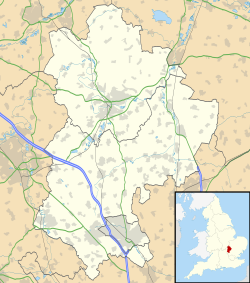RAF Henlow
| RAF Henlow | |||||||||||||
|---|---|---|---|---|---|---|---|---|---|---|---|---|---|
| Near Henlow, Bedfordshire in England | |||||||||||||

Labor Arma Ministrat (Latin: Labour supplies the arms)
|
|||||||||||||
|
Shown within Bedfordshire
|
|||||||||||||
| Coordinates | 52°00′56″N 000°18′12″W / 52.01556°N 0.30333°WCoordinates: 52°00′56″N 000°18′12″W / 52.01556°N 0.30333°W | ||||||||||||
| Type | Royal Air Force station | ||||||||||||
| Site information | |||||||||||||
| Owner | Ministry of Defence | ||||||||||||
| Operator | Royal Air Force | ||||||||||||
| Site history | |||||||||||||
| Built | 1918 | ||||||||||||
| Built by | McAlpine (1918) various since |
||||||||||||
| In use | 1918–Present | ||||||||||||
| Airfield information | |||||||||||||
| Identifiers | ICAO: EGWE | ||||||||||||
| Elevation | 47 metres (154 ft) AMSL | ||||||||||||
|
|||||||||||||
| Henlow Radio - 121.100 (Mhz) | |||||||||||||
RAF Henlow is a Royal Air Force station in Bedfordshire, England, equidistant from Bedford, Luton and Stevenage. It houses the RAF Centre of Aviation Medicine, the Joint Arms Control Implementation Group (JACIG), the Signals Museum and 616 Volunteer Gliding Squadron. The Ministry of Defence announced on 6 September 2016 that the base is set to be closed following a consultation.
Henlow was chosen as a military aircraft repair depot in 1917 and was built by MacAlpine during 1918. 4 Belfast Hangars were built and are now listed buildings. An additional hangar was added to the inventory in the 1930s and this too is now listed. Originally a repair depot for aircraft from the Western Front, the Station officially opened on 18 May 1918 when Lt Col Robert Francis Stapleton-Cotton arrived with a party of 40 airmen from Farnborough. In May 1920, RAF Henlow became the first parachute testing centre and was later joined by another parachute unit from RAF Northolt. Parachute testing was undertaken with Vimy aircraft and parachutists hanging off the wings and allowing the chute to deploy and enable them to drift back to the ground. The Officers Engineering School moved there in 1924 from Farnborough.
After the First World War, Henlow was home to four aircraft squadrons; No. 19 Squadron RAF, No. 23 Squadron RAF, No. 43 Squadron RAF and No. 80 Squadron RAF. Between 1932 and 1933, Sir Frank Whittle was a student at the RAF technical College on the base. He later spent some time in charge of aero engine testing on the base before being sent to Cambridge.
During the Second World War Henlow was used to assemble the Hawker Hurricanes which had been built at the Hurricane factory operated by Canadian Car and Foundry in Fort William, Ontario, Canada, under the leadership of Elsie MacGill. After test flying in Fort William, they were disassembled and sent to Henlow in shipping containers and reassembled. During Operation Quickforce in 1941, 100 fitters from the base were deployed onto carriers which were shipping Hurricane fighters to Malta. The finished Hurricanes were completed on the decks of the carriers and flown out to Malta. Over 1,000 Hurricanes (about 10% of the total) were built by Canadian Car and Foundry and shipped to Henlow. Henlow was also used as a repair base for many aircraft types under the direction of No. 13 Maintenance Unit.
...
Wikipedia

